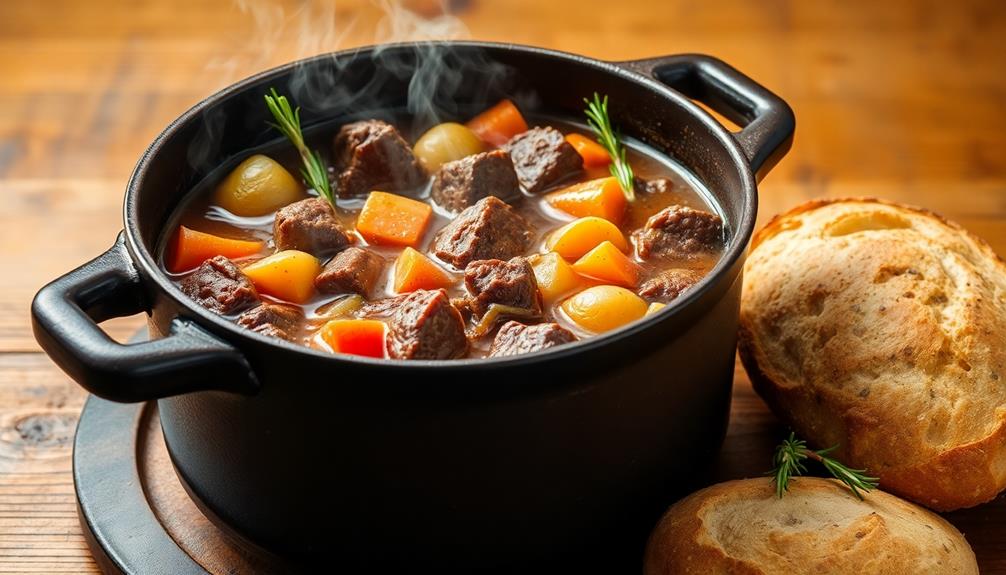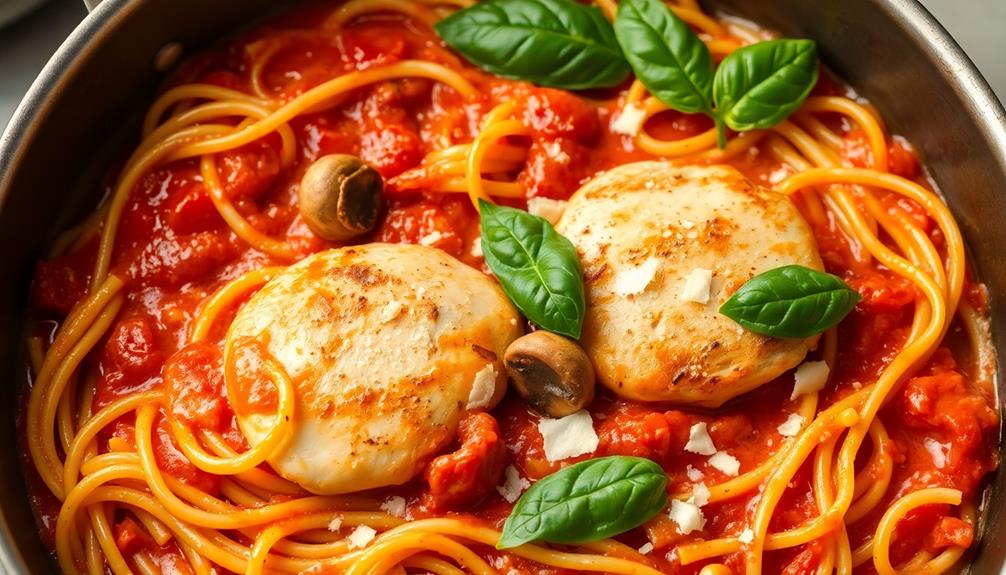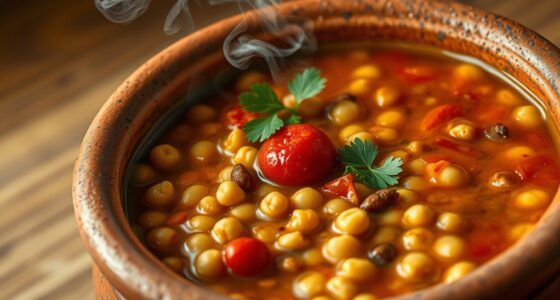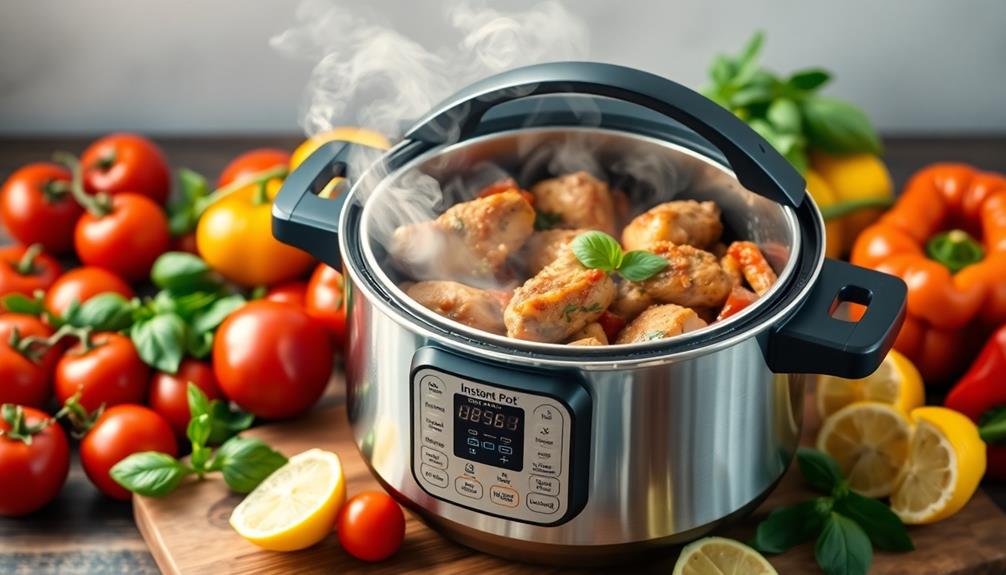You'll love whipping up a hearty Dutch oven beef stew! This classic dish has a long, rich history, with cast-iron cooking vessels used by pioneers and settlers for delicious, slow-cooked meals. The key is taking your time to brown the beef, sauté the veggies, and let all those flavors meld together as the stew simmers away. You'll end up with tender beef, carrots, potatoes, and herbs in a savory broth that'll warm you right up. Serve it with crusty bread or creamy mashed potatoes for a comforting and satisfying meal the whole family will enjoy. Want to learn more about this cozy classic?
Key Takeaways
- Dutch ovens originated in the 17th century as versatile cast iron cooking vessels, making them ideal for slow-cooking beef stew.
- Beef stew cooked in a Dutch oven benefits from the even heat distribution and moisture retention, resulting in tender meat and rich flavors.
- The recipe calls for browning the beef to develop a caramelized crust, then simmering the ingredients slowly to allow the flavors to meld.
- Fresh herbs, such as thyme and rosemary, are added to the stew to enhance the aroma and balance the savory broth.
- Serving the Dutch oven beef stew with crusty bread or mashed potatoes creates a hearty and comforting meal perfect for cold winter nights.
History
Dutch ovens have a long and storied history, dating back to the 17th century. These versatile cooking vessels were originally made of cast iron and used by pioneers, settlers, and homesteaders to create delicious, hearty meals over an open fire.
You can just imagine the mouthwatering aromas wafting through the air as they simmered stews, roasted meats, and baked bread in their trusty Dutch ovens!
The name "Dutch oven" may have come from the German word "Deutscher Ofen," meaning "German oven." These pots were particularly popular in the American colonies, where they were used to cook a wide variety of dishes.
Over time, Dutch ovens evolved, with modern versions featuring tight-fitting lids and legs to keep them stable over the fire.
Today, they remain a beloved kitchen essential, perfect for creating comforting, flavorful dishes like the classic Dutch Oven Beef Stew. Their enduring popularity is a testament to their versatility and the delicious meals they can produce.
Recipe
Dutch oven beef stew is a classic and comforting dish that's perfect for a cozy winter meal. The slow-cooking process allows the meat to become tender and the flavors to meld together beautifully. This recipe uses a variety of vegetables and seasonings to create a rich and satisfying stew.
The key to this dish is the use of a Dutch oven, which helps to trap the heat and steam, resulting in perfectly cooked and flavorful beef. The stew can be made in advance and reheated, making it an ideal meal for a busy weeknight or a weekend gathering.
Ingredients:
- 2 lbs beef stew meat, cut into 1-inch cubes
- 2 tbsp vegetable oil
- 1 onion, diced
- 3 carrots, peeled and sliced
- 3 celery stalks, sliced
- 3 cloves garlic, minced
- 2 tbsp tomato paste
- 2 cups beef broth
- 1 cup red wine
- 2 bay leaves
- 1 tsp dried thyme
- 1 tsp dried rosemary
- 2 medium Yukon Gold potatoes, peeled and cubed
- Salt and pepper to taste
Instructions:
In a Dutch oven, brown the beef in the vegetable oil over medium-high heat. Remove the beef from the pot and set aside.
Add the onion, carrots, celery, and garlic to the pot and sauté until the vegetables are softened, about 5-7 minutes. Stir in the tomato paste and cook for 2 minutes.
Pour in the beef broth and red wine, and add the bay leaves, thyme, and rosemary. Return the beef to the pot and bring the mixture to a boil.
Reduce the heat to low, cover, and simmer for 2 hours. Add the potatoes and continue to simmer for an additional 30-45 minutes, or until the beef and potatoes are tender.
Tips:
For the best flavor, use a high-quality beef broth and a full-bodied red wine. If the stew is too thick, thin it out with a bit of extra broth or water.
Adjust the seasoning with salt and pepper to your taste. Serve the stew with crusty bread or over mashed potatoes for a hearty and satisfying meal.
Cooking Steps
First, you'll brown the beef in the Dutch oven to create a delicious, caramelized crust.
Next, toss in the chopped veggies and let them simmer until they're nice and tender.
Finally, stir in the herbs and seasonings to really make the flavors pop.
Don't forget to garnish with fresh parsley for a fresh, vibrant finishing touch!
Step 1. Brown the Beef

After preparing the beef, you'll want to brown it in batches. This step is important because it adds a delicious, caramelized flavor to the meat.
Start by heating a tablespoon of oil in your trusty Dutch oven over medium-high heat. Once the oil is shimmering, gently place the beef cubes in the pot, being careful not to overcrowd them. Let the beef sizzle and brown on one side, about 2-3 minutes. Then, use a pair of tongs to flip the pieces and brown the other side.
Once the beef is nicely browned all over, transfer it to a plate. Repeat this process with the remaining batches of beef, adding a bit more oil if needed.
Don't worry if the bottom of the pot starts to look a little dark – that's just the delicious flavor developing! Just be sure to scrape up any browned bits, as they'll add incredible depth to your stew.
With the beef browned, you're one step closer to a comforting and absolutely mouthwatering Dutch oven beef stew.
Step 2. Add Vegetables
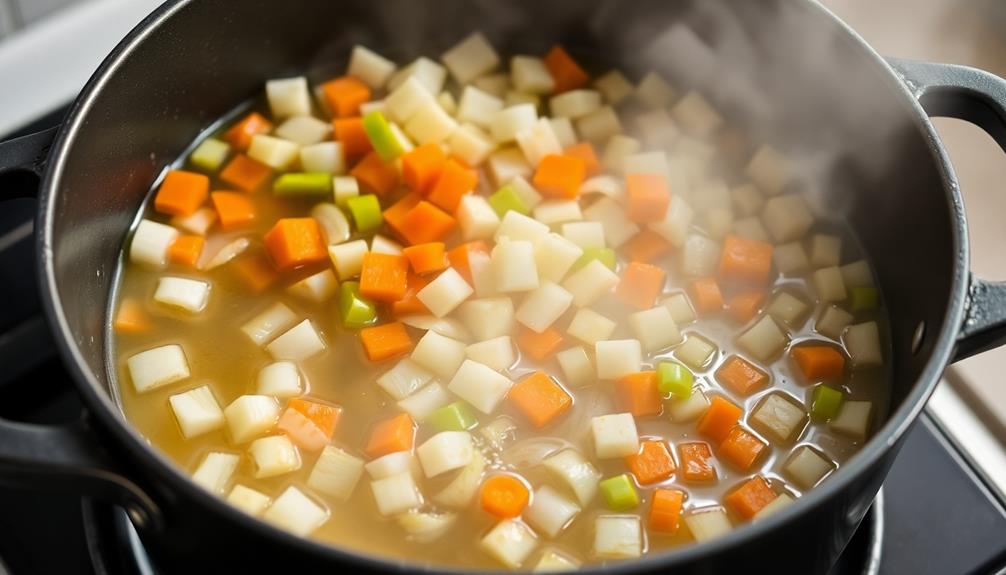
With the beef nicely browned, you can now turn your attention to the vegetables. First, peel and chop the onions, carrots, and potatoes. The aroma of the onions sizzling in the pot will make your mouth water!
Toss in the carrots and potatoes, and let them soak up all the beefy goodness. Don't forget to add the garlic – it'll give the stew a delicious savory flavor. As the veggies cook, they'll become tender and infuse the broth with their natural sweetness.
Next, pour in the beef broth and give everything a good stir. The liquid should just barely cover the ingredients.
Now, it's time to add the seasonings. A sprinkle of thyme, a dash of Worcestershire sauce, and a pinch of salt and pepper will do the trick. With a quick whisk, you've got a rich, aromatic base for your stew.
All that's left is to let it simmer until the vegetables are fork-tender. Get ready for a hearty, homemade meal!
Step 3. Simmer Until Vegetables Are Tender
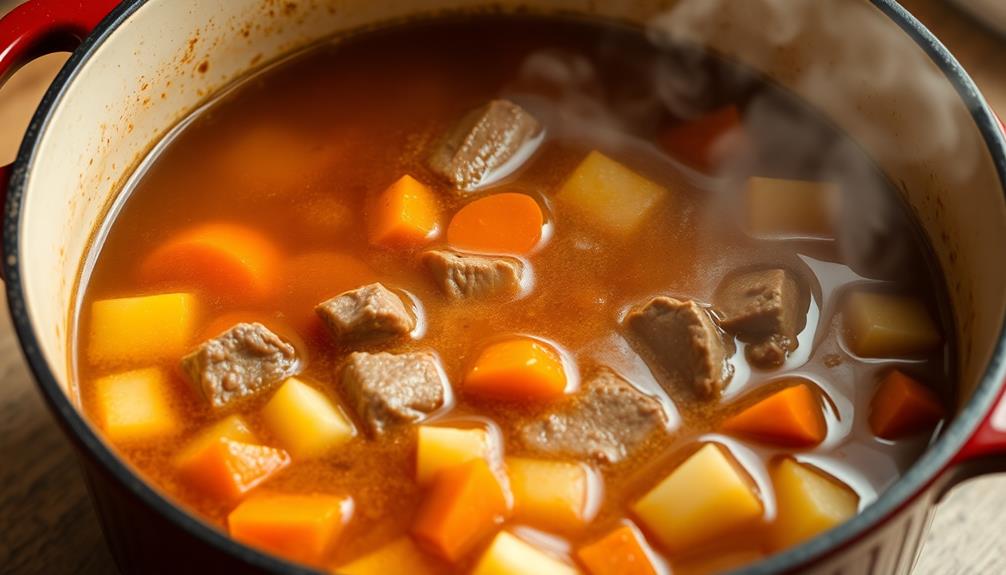
Once the vegetables have been added, let the stew simmer gently on the stovetop.
You'll want to keep the heat at a nice, low setting – just enough to maintain a gentle bubble. This slow, steady simmering is key to getting those vegetables nice and tender.
As the stew bubbles away, you'll start to notice the tantalizing aromas wafting through your kitchen. The hearty beef, the earthy potatoes, the fragrant herbs – it's enough to make your mouth water!
Keep an eye on the stew, stirring it occasionally to ensure the ingredients cook evenly.
After about 30-40 minutes, the potatoes and carrots should be fork-tender, signaling it's time to check for seasoning.
Give it a taste and add any extra salt, pepper, or herbs to suit your preferences.
Once the veggies are perfectly tender, your Dutch oven beef stew is ready to serve!
Ladle it into bowls and get ready to enjoy a comforting, homemade meal.
Step 4. Add Herbs and Seasonings

Now that the vegetables have had a chance to become tender, it's time to give your Dutch oven beef stew a final seasoning boost.
First, grab a handful of fresh thyme and rosemary and gently rub the aromatic leaves between your palms. Breathe in the earthy, savory scents as you sprinkle the herbs into the simmering stew.
Next, add a pinch of salt and a few grinds of black pepper, giving the pot a good stir. This will help the flavors meld together and really make the beef and veggies shine.
Don't forget a splash of Worcestershire sauce too – its umami richness will add depth and complexity to the dish.
Finally, taste the stew and adjust the seasoning as needed. You want the flavors to be bold, yet balanced, with the herbs and spices complementing the tender beef and soft vegetables.
Get ready, because your kitchen is about to smell absolutely divine!
Step 5. Garnish With Fresh Parsley

As the savory aroma of the herbs and seasonings fills your kitchen, it's time to add the finishing touch to your Dutch oven beef stew – a sprinkle of fresh parsley. This vibrant, fragrant herb not only adds a pop of color to your hearty dish but also enhances the overall flavor profile.
Grab a handful of lush, green parsley leaves and give them a rough chop. The delicate, slightly peppery notes of the parsley will complement the rich, beefy broth and tender chunks of meat perfectly.
Sprinkle the chopped parsley over the top of your stew, making sure to cover every bite.
As you serve the stew, the fresh parsley will release its aromatic oils, releasing a tantalizing scent that will have your family and guests eager to dig in.
The combination of the tender beef, savory broth, and bright, herbaceous parsley will create a truly satisfying and well-balanced meal. Enjoy this comforting and flavorful Dutch oven beef stew with your loved ones.
Final Thoughts
This Dutch oven beef stew is a comforting and satisfying dish that's perfect for chilly evenings. The combination of tender beef, hearty vegetables, and a savory broth is sure to warm you up from the inside out.
Don't you just love the way the aroma fills the air as it simmers away on the stovetop? It's enough to make your mouth water!
Once you've ladled up a steaming bowlful, you'll appreciate the time and care that went into crafting this delectable meal. The depth of flavor is truly remarkable, and each bite is a delightful explosion of tastes and textures.
Whether you're enjoying it on your own or sharing it with loved ones, this Dutch oven beef stew is sure to become a cherished favorite.
Go ahead, dig in and savor every last morsel – you deserve this cozy and comforting culinary experience!
Frequently Asked Questions
Can I Use a Slow Cooker Instead of a Dutch Oven?
Absolutely, you can use a slow cooker instead of a dutch oven. The slow cooker will allow the ingredients to simmer and tenderize over several hours, producing a delicious and flavorful dish just like a dutch oven would.
Do I Need to Brown the Meat Before Adding It?
Yes, you'll generally want to brown the meat before adding it to the slow cooker. This helps develop a nice sear and caramelized flavor that can't be replicated by just slow cooking the raw meat. This step also helps to lock in the juices and prevent the meat from becoming dry and tough during the slow cooking process. It’s an extra step that can make a big difference in the overall flavor and texture of the dish. Whether you’re making a stew, chili, or any other type of slow cooker recipe, taking the time to brown the meat beforehand is definitely worth it.
Can I Substitute Other Types of Meat in the Recipe?
Yes, you can substitute other types of meat in the recipe. The key is to choose a cut that's suitable for slow cooking, like pork shoulder, lamb shoulder, or even chicken thighs. Just adjust the cooking time as needed.
How Long Will the Stew Keep in the Refrigerator?
The stew will keep in the refrigerator for 3-4 days. Be sure to store it in an airtight container and reheat it thoroughly before serving. Proper storage is key to enjoying the leftovers later.
Can I Freeze the Leftover Stew for Later Use?
Yes, you can definitely freeze the leftover stew for later use. Just make sure to store it in an airtight container and it'll keep in the freezer for up to 3 months. This way, you can enjoy it again whenever you want.
